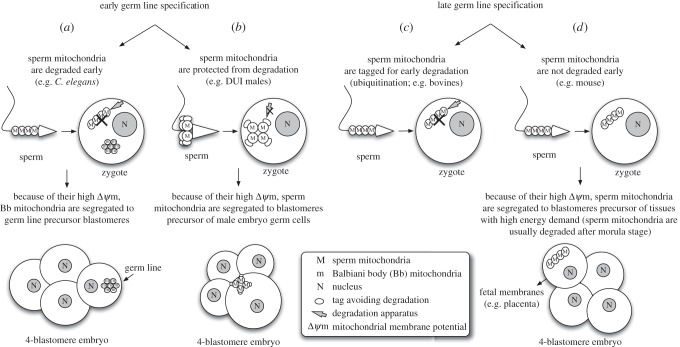Figure 1.
Germ line specification and mitochondrial segregation in germ cells. The timing of germ line specification would enable different mitochondrial segregation outcomes, as highlighted in different organisms. (a,b) In animals with an early mechanism of germ line specification, the hypothesized segregation of the most active mitochondria in gonadic presumptive blastomeres has to take place contextually. Examples: (a) in C. elegans, sperm mitochondria are degraded early by autophagy. This allows the segregation in germ line precursors of egg mitochondria with the highest inner membrane potential (Δψm). A similar process is predicted for DUI females. (b) In DUI males, the degradation of sperm mitochondria is prevented, and, owing to their having the highest Δψm, they are segregated to the blastomere precursor of male embryo germ cells. (c,d) When germ line specification is driven by inductive signals from surrounding tissues at a later developmental stage (as in mammals), at least two pathways of sperm mitochondria elimination are possible. Examples: (c) in some mammal species, such as bovines, sperm mitochondria are ubiquitinated and degraded shortly after fertilization owing to degradation tags attached during spermatogenesis or spermiation. (d) In the mouse, sperm mitochondria degradation appears to be postponed, but early segregation of these mitochondria into a specific blastomere actually prevents their spread. Therefore, mitochondria carried by the spermatozoon would have been already degraded (ubiquitination; c) or isolated in separate tissues (fetal membranes; d) when a subset of mitochondria is segregated into germ cell precursors.

